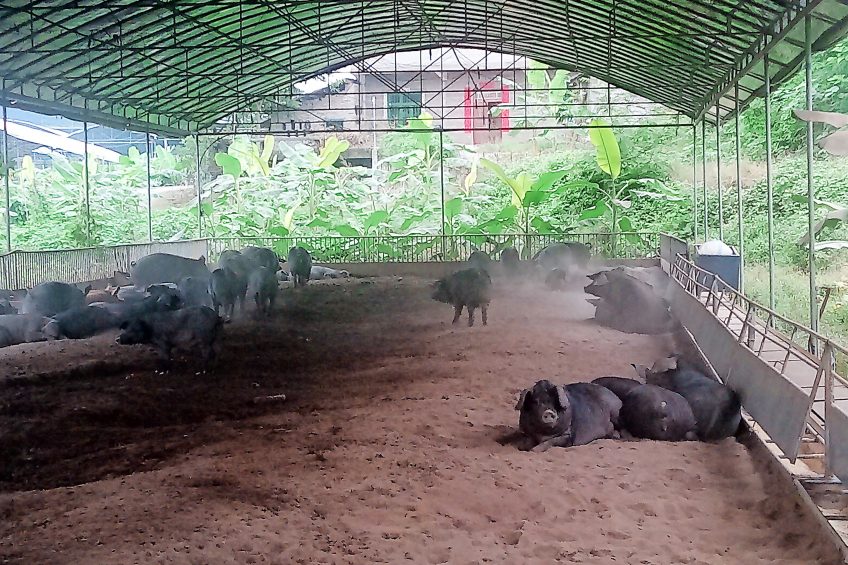Future looks bright for better pig welfare in China

It is clear that there is a growing interest in animal welfare in China with the first official welfare standards being signed in November 2017. Research, animal welfare standards, and certification are moving forward to catch up with international levels. What does it mean for China’s huge pig population?
In China, producers directly associate animal welfare (动物 dòngwù, animal and 福利 fúlì, welfare) with increased productivity. When animals are well cared for they will produce better, that is the thought. That is one major reason for producers to embrace the concept of animal welfare. Another reason for pig producers to adopt animal welfare standards is for reasons related to international trade. Large producers who wish to export to Europe may have to comply with EU standards.
Large farms are often built to European designs. European housing, which is often believed to mean better welfare, does however not always guarantee good animal welfare. For example, the use of the smaller Chinese breeds (like Meishan) may require adjustments. Especially the dimensions of farrowing crates can lead to welfare problems if they are not adjusted to the size of the pigs.

Read more about pig countries all over the world in our Country Focus Tool.
Trained staff vital to animal welfare
Regardless of facilities, animal handling often contributes most profoundly to welfare problems. Properly trained staff, who are aware of when animals feel pain or are distressed, are often lacking due to high turnover of stock workers. Larger farms where animal care takers have to remain on-site may be more vulnerable to this risk.
Welfare standards and legislation
Both the government (Chinese Agriculture Ministry) as well as society (through NGOs) are making efforts to set up welfare standards for livestock including pigs.
In November 2017, the Chinese Veterinary Medical Association (CVMA) had the first set of standards signed, called ‘China Animal Welfare Assessment General principles’. This happened by the National Animal Husbandry Standardisation Committee, part of the China Agricultural Ministry. The set of standards covers the scope, methods, basic principles and requirements for animal welfare evaluation. Dr Zhongchao Sun, on behalf of CVMA, mentioned that these were the first industry standards, passed by the government, which included the words ‘animal welfare’.
The International Cooperation Committee of Animal Welfare (ICCAW) is also actively developing welfare standards for livestock. This organisation drafted agricultural industry standards for the Chinese market, ‘General Standard of Animal Welfare: Livestock Products – General Standard’. This was commissioned by the Agricultural Product Quality Safety Supervision Bureau of the Ministry of Agriculture in 2017. This general standard also concerns the welfare of pigs. The ICCAW is informed by a large number of animal welfare researchers and is collaborating with international organisations, including RSPCA (UK). Standards are therefore likely to be formed based on the ones in Europe.
Meanwhile, the deputy of the National People’s Congress (NPC), Mr Wanping Zhao, has submitted the first proposal for farm animal welfare legislation to act at law level.
Progress by industry and NGOs
Since 2014, the ICCAW has organised the Good Pig Production Awards, in cooperation with animal welfare organisation Compassion in World Farming (UK). Producers are awarded when complying to voluntary welfare standards such as refraining from tail docking. In 2017, a total of 17 breeding companies won an award, including well-known companies such as the Beijing Capital Agribusiness Group (CAG), Yurun Group, Zhejiang Qinglian Food and Henan Huayang Agriculture and Animal Husbandry.
This year, awards were handed out at the first World Conference on Farm Animal Welfare, held in Hangzhou in October 2017, at about 180 km from Shanghai. The conference, organised by ICCAW, was hosted by FAO and China Association for the Promotion of International Agricultural Cooperation in Hangzhou and had 400 attendees from China and abroad.
At the opening, Yu Kangzhen, China’s vice-minister for agriculture for the first time openly announced the ministry’s stance towards animal welfare. He said that promoting farm animal welfare is a major task for all the stakeholders in the Chinese animal husbandry industry and that the government will accelerate the introduction of a country’s comprehensive animal welfare legislation (sources: FAO and CIWF).

In practice
The reality is that in practice there are still varying levels of welfare. Even producers that do follow animal welfare standards may do so for their market position and may not be too concerned with the actual welfare of the pigs. Also, the concept of animal welfare and, in the first place, the knowledge of animal suffering is marginal and cannot always be expected from the often temporary stock workers.
Moreover, there is a large gap between small holders and the large producers. The large producers, owning the vast majority of pigs, may be more inclined to adopt animal welfare standards to remain competitive in the market. Smaller producers however may have less incentive. It is encouraging though that animal welfare is increasingly mentioned at Chinese conferences and platforms for producers, such as the Global Pig Forum (May 2017, Qingdao).
Moreover, the long-standing research efforts of Chinese professors in animal welfare, most notably Prof Jun Bao (Northeast Agricultural University), now gains national and international attention. An example of that is a book chapter on the development of animal welfare in China by J. Bao and Y. Li in the book ’Animals and us: 50 years and more of applied ethology’ in 2016.
Also read: Yangxiang aims high with sows on many floors
What to expect in 2018?
The immediate future looks bright for an increase of animal welfare standards in China. From 23-25 October 2018, a second edition of the World Conference on Farm Animal Welfare will follow. There is an increase in research funding for collaboration between European countries and China.
In 2017, a large number of research projects have been funded to improve animal welfare in China, mainly due to collaborations between China and European universities and NGOs. The international collaboration and clear development of standards may give rise to rapid progress in the near future to improve farm animal welfare.











